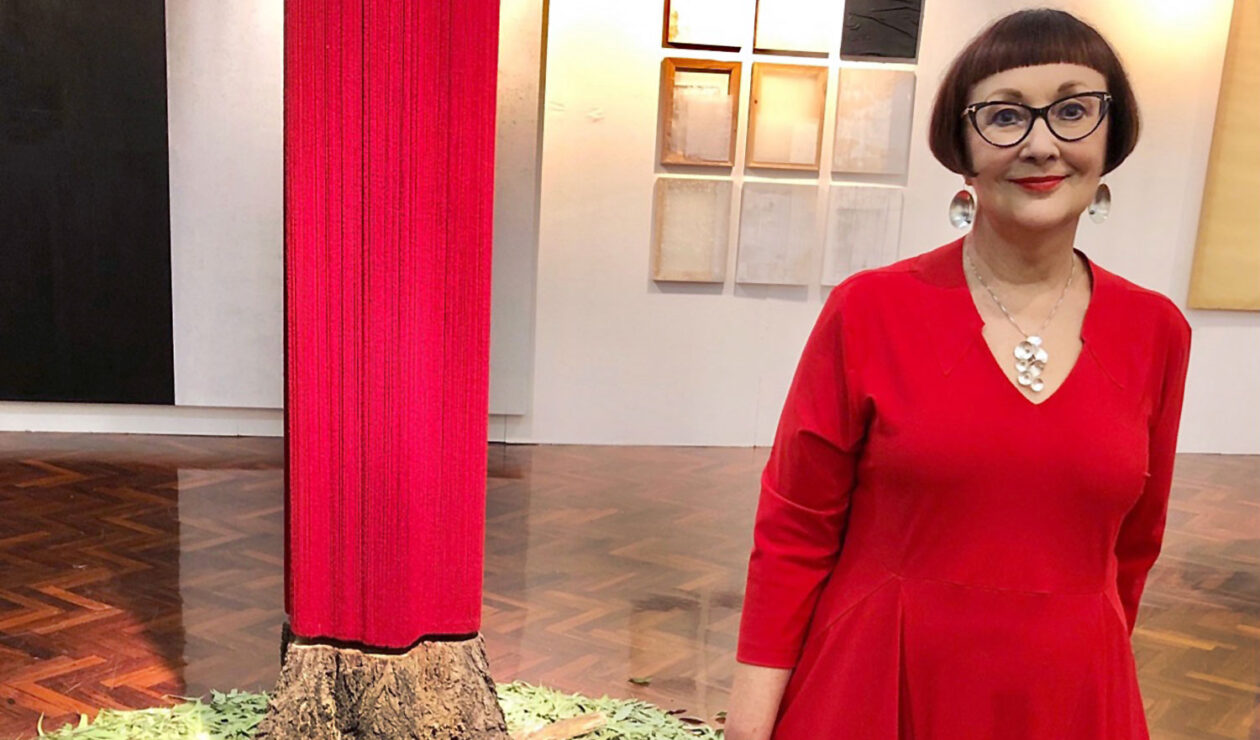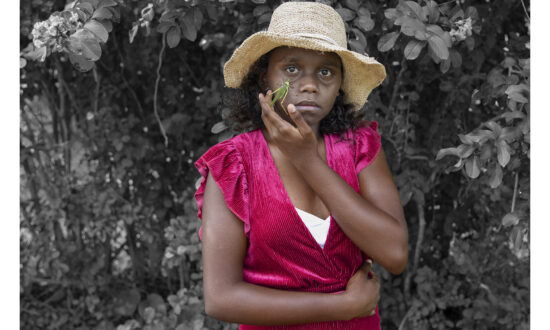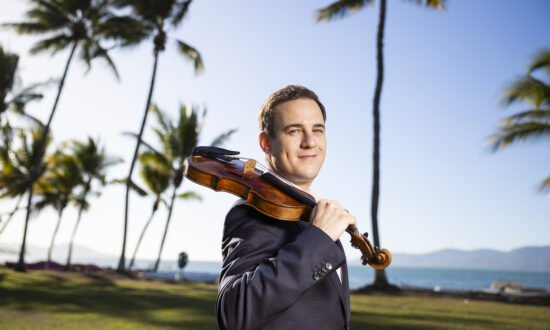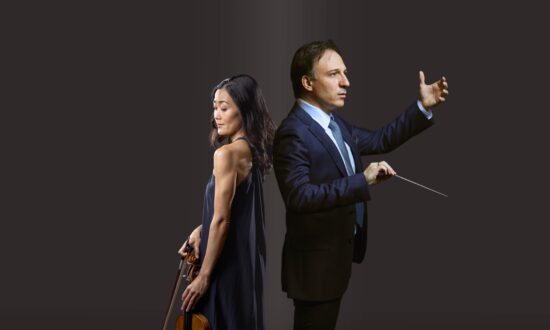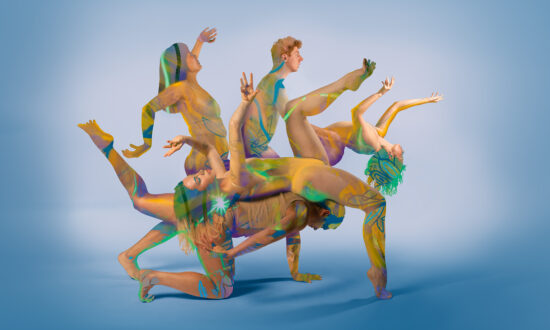Few connoisseurs of the Adelaide art world have as iconic a presence as Diana Jaquillard – but beyond her immaculate style, working with husband Philippe, she has for nearly 25 years invested in and transformed the careers of our state’s emerging artists.
Henry Wolff, Helpmann Academy engagement and development manager, sat down with Diana to seek her advice about collecting, and to chat about what inspires her passion for the arts.
You’ve been a long-term and prolific supporter of the arts, and have been involved with Helpmann Academy for quite a while – what inspires you to give?
I graduated from SASA (South Australian School of Art) in the 1970s, majoring in graphic design. In those days, it was a much more holistic course, being four years instead of three.
The first year for all students was heavily fine-arts-orientated and an excellent grounding, including painting, general drawing, life drawing, history of art, anatomy, perspective drawing, printmaking, sculpture and more.
Some of my lecturers during my studies were part of the Progressive Art Movement (PAM), a small but tough arts organisation active in Adelaide between 1974 and ’78. Recently I attended the FUMA (Flinders University Museum of Art) exhibition If you don’t fight… you lose, revisiting the prints and posters of the era. The exhibition was part of South Australia’s History Festival 2024, the theme for which was POWER.

From the Helpmann Academy archives: Diana Jaquillard (right) with Elsie Gleghorn, Patricia Chigwidden and artist Richard Maurovic at an early Helpmann event at Fisher Jeffries.
My next three years of study was focussed on graphic design, which then also included illustration, photography, fashion drawing and life drawing. There were no computers involved until 1986, so it was all done manually.
I made an economic decision to study graphic design, but was fortunate to have had a further comprehensive appreciation of the arts instilled in me by being enriched by, immersed in, and able to observe the process of creation of the diverse, colourful, cerebral artworks made by my cohorts studying in the fine arts departments.
This environment nurtured a love of the arts, started me on my journey as an art collector when still a student, and gave me a strong awareness early in life of the difficulties of achieving success and making a living as a fine artist.
It stimulated my synergy with Helpmann Academy around 24 years ago, as the president of the Helpmann Friends Committee, then with two stints (including my current position) as a member of the Helpmann Academy Foundation Board, which raises funds for grants, awards, residencies, mentorships and much more.
Helpmann Academy assists emerging artists in the visual and performing arts in three universities during their studies, as well as up to five years after graduation.
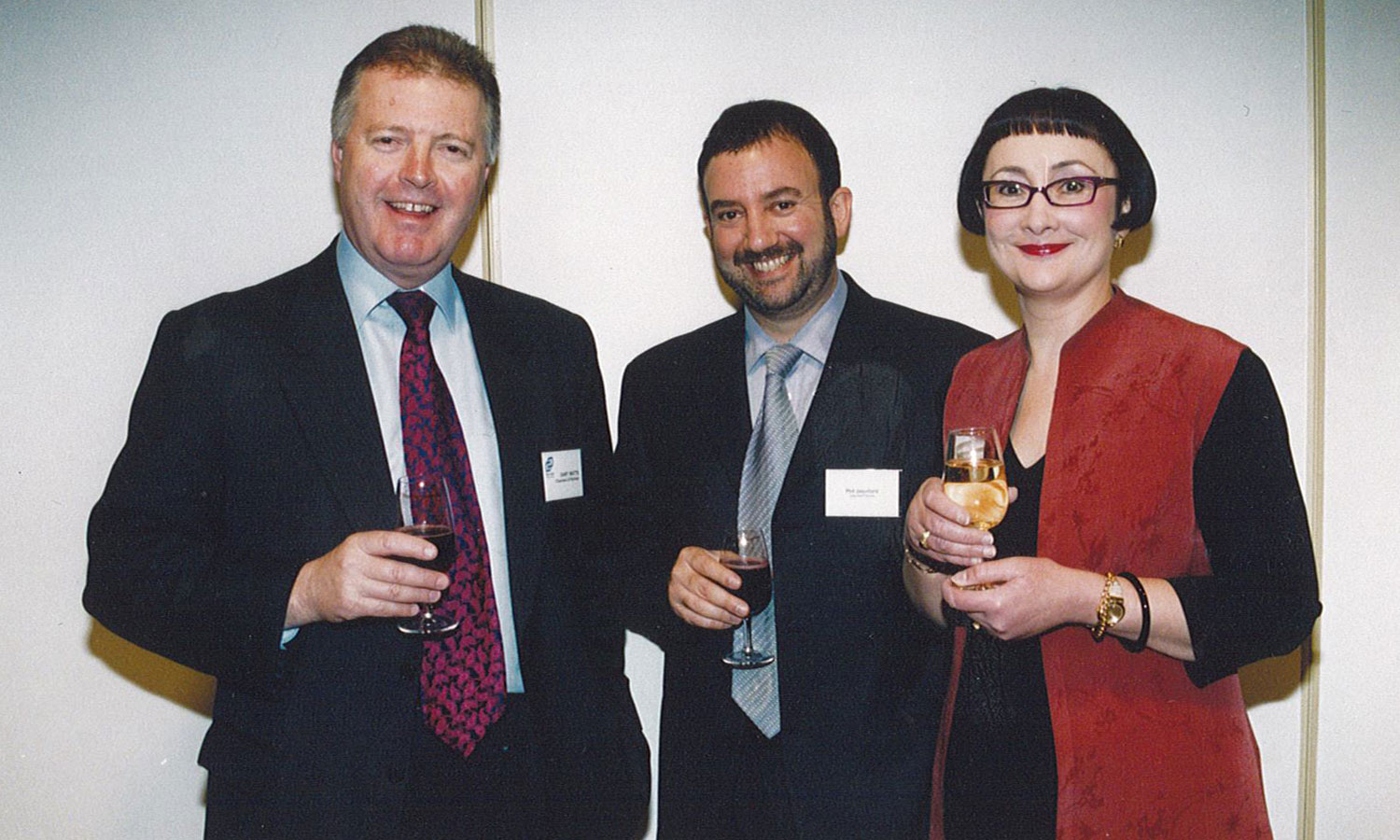
From the Helpmann Academy archives: Diana and Philippe (centre) Jaquillard with arts supporter and past chair of the Helpmann Academy board of governors Gary Watts attending an early Helpmann event at Fisher Jeffries.
Philippe and you have collected for many years and have kept the works together in your private warehouse. Are there any stories about the artists or works you’ve collected that have stuck in your mind?
Yes, my husband Phil, who is a chartered accountant, has shared my passion for the arts, as well as being a generous supporter of the arts. He has an excellent aesthetic sensibility and is a lover of visual and performing arts, including film, ballet and photography.
He acknowledges, as I do, the importance of giving to society to assist the arts, which enriches us all, and to charitable organisations. Phil was a long-term volunteer board member as treasurer of Sight For All and the Mary Potter Hospice.
Yes, we have artworks in our warehouse, as well as our home, offices and other properties, because art enhances many kinds of environments.
We have many stories about fascinating studio visits, artwork acquisitions and all of the friendships that they have engendered along the way.
Our art collection comprises a mix of mid-career, Indigenous, renowned Australian and international artists, in a variety of genres and media. A few of these include artists as diverse as Reko Rennie, Del Kathryn Barton, Paul Yore, Tom Gleghorn, Robert Juniper, Rafa Macarrón, Chen Man, Tom Moore, Clare Belfrage, Gareth Sansom, Owen Yalandja, Salvador Dali, Ivor Hele, Robert Hannaford, Giles Bettison, Gerry Wedd, Bert Flugelman, The Huxleys, Hush, Frank Bauer, Ray Caesar (Toronto), Sally Bourke and Joan Ross.

From the Jaquillard collection: Del Kathryn Barton, she came vivid and unbidden, acquired in 2023. Photo courtesy Diana Jaquillard
It also includes the works of artists supported by Helpmann Academy when they were emerging, such as Liam Fleming, Anika Gardner, Michael Carney, Oakey, Jeremy Piert, Janice Vitkovsky, Laura Wills, and Rosina Possingham + Brianna Speight.

Installation view of Oakey’s Totem Grove in the Helpmann Academy Graduate Exhibition 2020. The work was purchased by Diana at the exhibition and has been on display in the Jaquillards’ warehouse. Photo: Diana Jaquillard
We have a love of three-dimensional works, so we collect glass, ceramics and sculpture as well as paintings and digital art.
We count many artists amongst our friends collected along the journey, follow the careers of the artists whose works we have acquired or provided awards to, and stay in touch with many. All have been generous in providing narratives about their rationales, motivations, methods and developing careers, and with advice or assistance in effecting art installations.
The stories are too many to tell, but each of our artworks has a memorable story attached to it which includes warm experiences, personal interactions and travel to exotic places to art fairs. The art world is an enthralling world to inhabit, because it includes so many sensory experiences including colour, texture, paint, textiles, music, dance, theatre, film, as well as all the captivating and intriguing characters that inhabit it!
I understand that the warehouse is to be demolished. What changes do you believe will happen because of this, and is there anything that will be lost as a result of the compulsory acquisition?
Yes, sadly our warehouse, which is only six years old, is being acquired compulsorily by the Government because the land is required for the South Road widening project, even though it is not on South Road, but several blocks back.
We will lose a near-new concrete warehouse, all the effort required to design, build and curate it, a large public artwork which we commissioned that was painted on the outside, and much time trying to find a warehouse replacement.
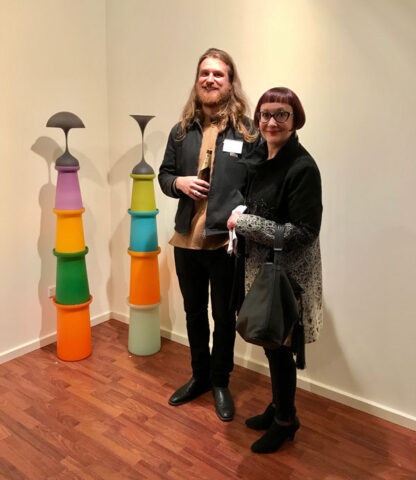
Diana Jaquillard with glass artist Liam Fleming and his works produced as a result of a Helpmann Academy Sanskriti Kendra Residency in India. These works were exhibited at the Helpmann Academy Kaleidoscope exhibition hosted by Peter Walker Fine Art Gallery, The right-hand work is part of the Jaquillard collection. Photo courtesy Diana Jaquillard
You often have championed the work of emerging artists, collecting works from some of our state’s most promising new talent. How impactful is this support for artists early in their career?
It’s certain that when a known collector believes in an artist enough to purchase their work, that it has the huge psychological effect of affirmation of skills and endorsement, as well as providing much-needed financial resources to continue.
I have always tried to help artists in various ways, such as giving career advice, directing them to grants schemes, discussing resources that they can utilise and without which they may not be able to afford to continue.
I am proud to be involved with Helpmann Academy, which is one of the most valuable providers of assistance to artists in South Australia. It is the only organisation of its kind in Australia. It provides professional development opportunities including grants, awards, fellowships, mentorships, masterclasses, workshops, advisory services, local and international artist residencies, all tailored specifically for South Australia’s higher-education students, graduates and emerging artists.
Do you have any advice for people about collecting, and how they can go about collecting emerging artist works?
Yes! There is an active arts community in South Australia. For example, you can purchase emerging artists’ work from the Helpmann Academy’s annual Graduate Exhibition held in mid-February each year.
This year, 22 visual artists from Flinders University and the University of South Australia showcased their graduate works at this prominent arts event at SASA Gallery. A large range of disciplines were for sale, including ceramics, glass, moving image, painting, photography, printmaking, sculpture, fashion, costume design, and textiles. It’s a wonderful opportunity to purchase quality artworks for a reasonable price that may appreciate as the artists’ careers advance – as some of my artworks have!
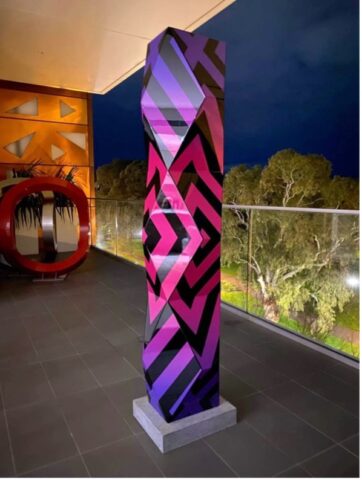
From the Jaquillard collection: (L-R) James Worth, Freeform Dancers, and Reko Rennie, Totem. Photo courtesy Diana Jaquillard
In South Australia there are private galleries, organisations, artist-run initiatives and council-run galleries that offer a range of exhibitions throughout the year where you can purchase works. For example, you can find Helpmann Academy alumni works available at JamFactory, Hugo Michell Gallery, GAGprojects and Hill Smith Art Advisory. And emerging artists are often exhibited at praxis ARTSPACE, Newmarch Gallery, Gallery M, Floating Goose and many more.
Of course, there is also SALA – South Australian Living Artists Festival, the open-access visual arts festival held annually during August all over our state. This comprises artworks by established, emerging and amateur artists. Founded by Sam Hill-Smith and Paul Greenaway OAM, SALA involves over 600 venues across the state, and over 9000 participating artists.
For several years, you and Philippe have been responsible for the Jaquillard Exhibition Award, presented annually at the Helpmann Academy’s Graduate Exhibition. Through the award you have supported countless visual artists to undertake exhibitions. What has the impact from this looked like for you?
Phil and I find presenting this award a privilege and extremely heart-warming. We instituted the award of $3000 annually to assist an emerging artist in facilitating their first exhibition. Artists often can’t afford the multiple canvases, framing, plinths or other materials required, so we wish to help support this endeavour.
We have felt the sincere gratitude, and it has often fostered a long-term association.
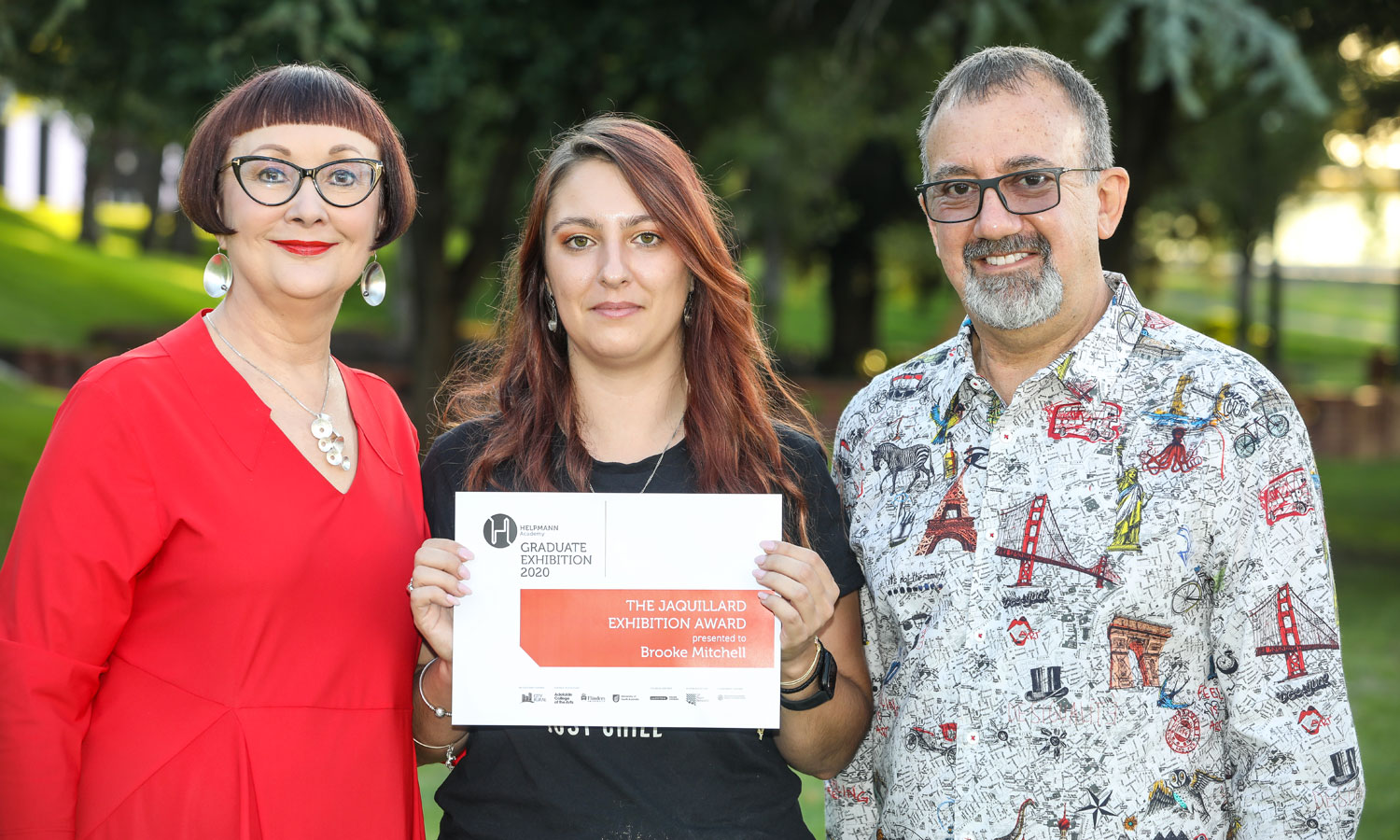
Diana and Philippe Jaquillard presenting the Jaquillard Exhibition Award to artist Brooke Mitchell at the Helpmann Academy Graduate Exhibition 2020.
How important do you think support to exhibit works is for the next generation of artists?
It is even more important than ever, because of the continual expansion of online digital media. This is also a valid form of art which is more easily accessible, but it makes it more difficult for traditional artists who make by hand and wish to exhibit in a physical premises.

Get InReview in your inbox – free each Saturday. Local arts and culture – covered.
Thanks for signing up to the InReview newsletter.
Do you have any suggestions on how people can get involved with supporting emerging creatives?
Attend exhibitions, buy original art and craft, and donate to bodies like Helpmann Academy. You can even establish your own award to present at the annual Helpmann Academy Graduate Exhibition!

Pam McKee, Diana Jaquillard and the Hon Diana Laidlaw AM at the Helpmann Academy Macquarie Fundraiser, 2023. Photo: Sia Duff
Henry Wolff is a visual artist and arts worker living and working on Kaurna Country.
Support local arts journalism
Your support will help us continue the important work of InReview in publishing free professional journalism that celebrates, interrogates and amplifies arts and culture in South Australia.
Donate Here
